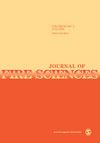用于测量入射热通量的小尺寸板温度计的研制和校准
IF 1.9
4区 工程技术
Q2 ENGINEERING, MULTIDISCIPLINARY
引用次数: 2
摘要
为了解决传统平板温度计在火灾环境中测量入射热流时,由于平板面积大、平板温度分布不均匀导致空间分辨率低的问题,本研究提出了一种外形改进、保温性能提高的小尺寸平板温度计。本研究的主要结果表明,新型平板温度计具有较高的空间温度均匀性,并且可以将平板温度计的尺寸缩小到30 mm。此外,研究发现,与热流计相比,使用以热流计的三阶多项式函数表示的传导校正因子,而不是使用在广泛的热流计范围内测量计算的平均经验常数,大大减少了平板温度计入射热流的相对误差。最后,验证了新型缩小板测温仪在庚烷池火灾中测量的入射热流密度与热流密度计在火灾快速生长、充分发育和衰减阶段的测量结果吻合较好。本文章由计算机程序翻译,如有差异,请以英文原文为准。
Development and calibration of reduced-size plate thermometer for measuring incident heat flux
This study proposes a new reduced-size plate thermometer with a modified shape and improved insulation performance in order to resolve problems commonly found when using conventional plate thermometers to measure incident heat flux in fire environments, for example, a low spatial resolution caused by the large plate area and a non-uniform temperature distribution on the plate. The main results of this study showed that the new plate thermometer exhibits high spatial temperature uniformity, and that the plate thermometer can be reduced in size to 30 mm. Moreover, it was found that the relative error of the incident heat flux of the plate thermometer was substantially reduced compared to that of a heat flux meter using a conduction correction factor expressed as a third-order polynomial function of heat flux, rather than using an average empirical constant calculated from measurement over a wide range of heat fluxes. Finally, it was confirmed that the incident heat flux measured by the new reduced-size plate thermometer in a heptane pool fire was in good agreement with the heat flux meter measurements during the rapid-fire growth, fully developed and decay phases of a fire.
求助全文
通过发布文献求助,成功后即可免费获取论文全文。
去求助
来源期刊

Journal of Fire Sciences
工程技术-材料科学:综合
CiteScore
4.00
自引率
0.00%
发文量
14
审稿时长
2.5 months
期刊介绍:
The Journal of Fire Sciences is a leading journal for the reporting of significant fundamental and applied research that brings understanding of fire chemistry and fire physics to fire safety. Its content is aimed toward the prevention and mitigation of the adverse effects of fires involving combustible materials, as well as development of new tools to better address fire safety needs. The Journal of Fire Sciences covers experimental or theoretical studies of fire initiation and growth, flame retardant chemistry, fire physics relative to material behavior, fire containment, fire threat to people and the environment and fire safety engineering. This journal is a member of the Committee on Publication Ethics (COPE).
 求助内容:
求助内容: 应助结果提醒方式:
应助结果提醒方式:


